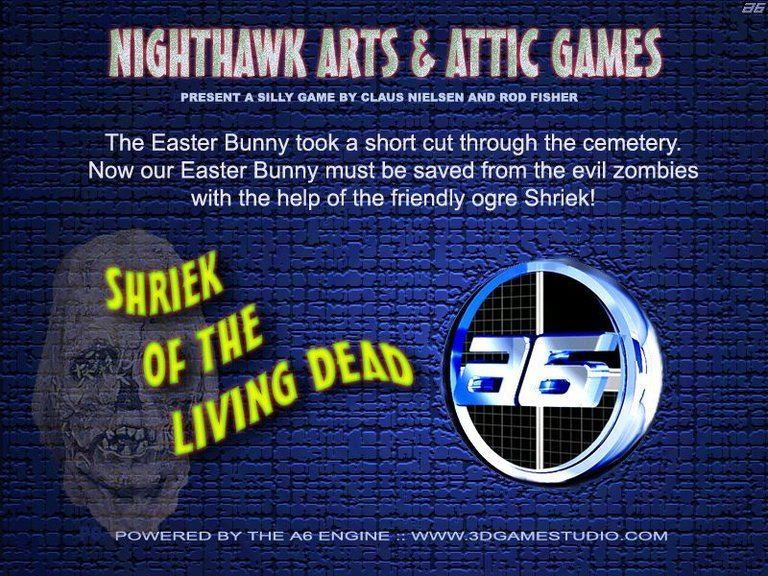- Release Year: 2006
- Platforms: Windows
- Publisher: Attic Games
- Developer: Attic Games, Nighthawk Arts
- Genre: Action
- Perspective: Top-down
- Game Mode: Single-player
- Setting: Cemetery
- Average Score: 4/100

Description
Shriek of the Living Dead is an action game where the player controls the ogre Shriek to rescue the Easter Bunny from zombies in a cemetery. The objective is to club 100 zombies before the time runs out to save the bunny, and avoid letting the bunny touch any zombies, which would result in health loss.
Patches & Updates
Mods
Guides & Walkthroughs
Reviews & Reception
myabandonware.com (4/100): Big fan of Shriek! Unfortunately Dreamworks stole the design of Shriek for their cleverly named … Shrek. SAD!
Shriek of the Living Dead: An In-Depth Analysis
Introduction
Propelled by its whimsical take on a post-apocalyptic scenario, ‘Shriek of the Living Dead’ (2006) amalgamates Easter, zombies, and the tender-hearted ogre Shriek for an unforgettable, albeit short-lived, gaming experience. Released during the peak of the indie gaming boom, this obscure gem from Attic Games curiously blends horror and holiday cheer, creating a charm that set it apart from more serious zombie titles of the era.
Development History & Context
Originally conceived as an entry for the Caiman Easter contest (2006), ‘Shriek of the Living Dead’ epitomizes the spirit of that era’s indie development scene. Spearheaded by Rod Fisher and Claus Nielsen, the game reflects the duo’s ingenious creative vision within the constraints of contemporary technology, delivering a surprisingly polished product, particularly considering its humble beginnings.
The game marks a testament to the early 2000s indie scene, where innovative stories and gameplay concepts transcended technical limitations. Players of the era, particularly fans of “wonky” titles like the Serious Sam series, would find this quirky game refreshing.
Narrative & Thematic Deep Dive
At its core, ‘Shriek’ is a zany mixture of survival horror and EGM (Event Game Magic). It unfolds with the Easter Bunny seeking a shortcut through a cemetery, only to find itself besieged by zombies. The brave ogre Shriek, a comically oversized creature, responds to the Bunny’s distress call, embarking on a quest to save them. The narrative makes no pretenses to depth, focusing instead on providing a humorous twist on the traditional zombie apocalypse genre.
Gameplay Mechanics & Systems
‘Gameplay shines with its straightforward mechanics, relying on the tight controls and fun premise to compensate for what, by today’s standards, might seem like minimal depth. The primary objective is simple: keep Shriek slamming flesh-eaters before time runs out. Controls are intuitive, utilizing the mouse for both movement and targeting.
The character progression system, albeit basic, effectively drives engagement through a points-based reward system. As the player slams more zombies, they climb leaderboards worldwide, fostering a sense of competition among players.
World-Building, Art & Sound
Visually, the game maintains a consistent isometric view, reminiscent of early DOS ‘Z’ and ‘Road Rash’. The art style is suitably macabre for the zombie setting but remains stylized enough to maintain its quirky holiday undertones. The visual elements complement the game’s tongue-in-cheek approach, never taking itself—or its premise—too seriously.
Reception & Legacy
Upon release, critical reception was mixed, with some praising its originality and others criticizing its shorter playtime for its adult-to-youth price point. Remarkably, despite its limited commercial success, the game gained a dedicated cult following. It catapulted its developers into local gaming scenes and inspired a trend in ‘zombie rescue’ indie games throughout the following decade.
Conclusion
In conclusion, ‘Shriek of the Living Dead’ stands as a time capsule of the early 2000s indie gaming scene, brimming with creativity and charm despite its modest origins. Despite its brevity, the game leaves a lasting impact for its innovative blend of genres, hopping between Easter celebrations, zombie carnage, and the unexpected heart of its oversized protagonist, offering a unique experience that transcends its technical limitations. Its legacy endures as one of the most genuinely unusual indie titles of its era, a must-play for fans of unconventional gaming experiences.